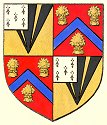 |
A SHORT HISTORY OF TETTENHALL11. The nineteenth century - new people and new schools |
|
 |
A SHORT HISTORY OF TETTENHALL11. The nineteenth century - new people and new schools |
|
|
A school had been established in the village in 1776, apparently in the chancel of the church but later moving into the vestry, which became the school room. In or about 1826 this school became the National School with new buildings near Lower Green. It was extensively altered in 1873 and then completely rebuilt in the 1880s. The infants' school, which later became the Christ Church school, was founded about 1845. In 1874 Miss Theodosia Hinckes, of the Wood House, gave land for a senior school at Tettenhall Wood.
In addition to these schools Tettenhall seems to have been seen as a
very suitable place for fee paying schools, of which there were several
during the nineteenth century. Of these the one that survived and grew
biggest was Tettenhall College, founded in 1863 by Free Church men from
Wolverhampton's Queen Street Congregational Church and the Waterloo Road
Baptist Church, for the express purpose of educating boys outside the
influence of the Church of England.
The school started in Francis Holyoake's old house (now known as the
Headmaster’s House) and large new buildings were added in 1865 and 1867.
Eventually the school took over Tettenhall Towers, which had been the
residence of Colonel Thorneycroft.
The Holyoakes family had built the house and were one of the first rich families who, increasingly as the nineteenth century went on, saw Tettenhall as a good place to build large houses. These families, who had no landed estates in the area, had made fortunes in the manufacturing and service industries of Wolverhampton and even as far away as Bilston. Tettenhall was seen as a picturesque village with healthier air than in the industrial areas.
In addition to Holyoake, Thorneycroft and Hinckes, we can list the Hickmans, who succeeded the Hinckes at Wood House and who also owned Tinacre Hall (now known at Wightwick Hall); Edward Perry, the japanner, who built Danescourt; Henry Hartley Fowler, the politician and later the first Lord Wolverhampton, who built Woodthorne (where DEFRA now is); the Mander family who built Wightwick Manor, the Mount and the Dippons; and other somewhat lesser mortals who built large houses, mainly along Wood Road. The middling sort were not to be neglected and there were terraced houses around Limes Road and Manor Street.
Another secondary impact of industrialization was the building, by Wolverhampton Corporation, of a large waterworks in what is now Regis Lane but which was called Waterworks Lane. Water was pumped from boreholes and stored in large reservoirs, now removed and replaced by housing. |